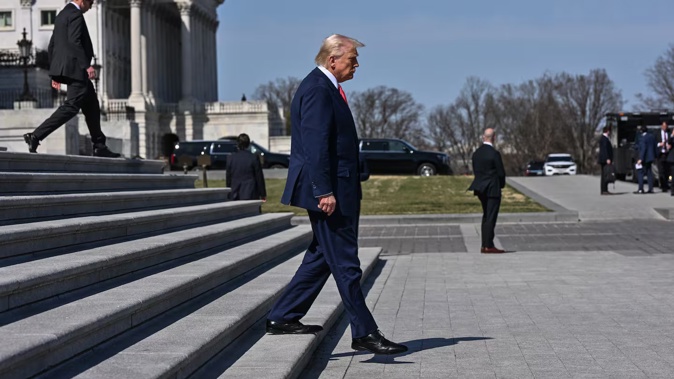
President Donald Trump once again catapulted crime in Washington DC into the national conversation this week, putting District police under United States federal control today and deploying the National Guard to fight crime.
It follows an incident in which a young federal staffer was beaten in an attempted carjacking.
“It has become one of the most dangerous cities anywhere in the World. It will soon be one of the safest!!!” Trump said in a weekend Truth Social post, pledging action that will “essentially, stop violent crime in Washington, DC”.
In a news conference today, Trump said he has ordered a federal takeover of the DC police and would deploy 800 National Guard troops, who will be armed and have the ability to conduct arrests if needed.
Over the weekend, he ordered more federal law enforcement agents to be deployed on city streets and called for teenagers as young as 14 to be charged as adults as he continues to cast the capital as over-run with violent youngsters.
Local and federal data, though, paint a contrasting picture.
DC police have made about 900 juvenile arrests this year - almost 20% fewer than during the same time frame last year.
About 200 of those charges are for violent crimes, and at least four dozen are for carjacking.
This northern summer, DC officials have also implemented stricter curfew laws for teens in response to concerns about large brawls - recorded in videos that spread on social media - breaking out in communities across the city.
Violent crime in DC has been on the decline since 2023, when a generational spike in killings rendered the nation’s capital one of America’s deadliest cities, plunging communities into grief and igniting a local political crisis that escalated to Congress.
The decrease since then is part of a nationwide drop over the past two years that in 2024 brought homicide rates to their lowest level in decades.
This year, homicides are down more than 30% in data that the Washington Post collected from more than 100 police departments in large US cities. Reports of burglaries and robberies also dipped by double-digit percentages.
Discussing crime today, Trump pointed to other cities that he said “are bad, very bad”, appearing to suggest the federal government could take action in places beyond Washington.

Jeanine Pirro, US Attorney for Washington, DC, holds a news conference. Photo / Tom Brenner, for The Washington Post
“You look at Chicago, how bad it is. You look at Los Angeles, how bad it is. We have other cities that are very bad. New York has a problem.
“And then you have, of course, Baltimore and Oakland,” Trump added, calling them “so far gone”.
Every city Trump mentioned by name has seen homicide and violent crimes decline this year.
Not captured in statistics, though, is the grief, pain, and shattered sense of safety that follow each crime.
A few hours before 19-year-old software engineer and Elon Musk protege Edward Coristine was beaten, a man suffered a non-fatal gunshot wound.
Later that day, a 27-year-old man would be fatally shot blocks from the Capitol.
The following night, a 38-year-old Northwest Washington resident was killed in gunfire in Columbia Heights.
None of these crimes made national headlines.
But the image Trump shared of Coristine continues to ricochet online.
Last week, the President described crime in DC as “out of control”, with young “thugs” and “gang members” who are “randomly attacking, mugging, maiming, and shooting innocent Citizens”.
DC Mayor Muriel Bowser (Democrat) refuted that image on Monday, noting the recent drops in crime while adding that the city could use the federal government’s help with other law enforcement priorities, such as adding more prosecutors and judges in the city.
“If the priority is to show force in an American city, we know he can do that here,” Bowser, who had been silent since the President initially threatened to take over the city, said of Trump in an interview on MSNBC.
“But it won’t be because there’s a spike in crime.”
FBI arrest data collected by the Washington Post shows juvenile arrests nationwide have largely been dropping since the 1990s.
In 2024, the rate was about 439 arrests per 100,000 juveniles, down 7% from 2023 and five times lower than in 1997.
Juvenile arrests are down in DC this year, but the trend doesn’t hold everywhere.
In Baltimore, police made 1377 juvenile arrests in 2024, a 47.4% increase from the previous year, according to FBI data.
In New York City, juvenile arrests were up 10.9% in 2024 compared with 2023 and are continuing to rise. New York police made more than 5200 arrests from January through June this year, up almost 10% from the same period the year before.
And Chicago is seeing an even sharper rise, but the juvenile arrest count there remains less than half of the 2019 figure.
US Attorney Jeanine Pirro, the Trump-appointed prosecutor who handles most of DC’s adult crime, said the nation’s capital shields violent youngsters from consequence.
She joined the President in advocating that more teenagers, including those as young as 14, be funnelled into the adult justice system. In DC, suspects as young as 15 can be charged as adults.
“Young people are coddled, and they don’t need to be coddled anymore,” Pirro said last week at a news conference. “They need to be held accountable.”

A sign in response to the city's summer curfew on youths. Photo / Eric Lee, for The Washington Post
Eduardo Ferrer, policy director of Georgetown Law’s Juvenile Justice Initiative, said it was important to keep in mind that the vast majority of DC’s teenagers are doing the right things.
And for that minority of young people who commit serious violent crimes, the solution should not be charging them as adults, Ferrer said.
He pointed to an influential Centres for Disease Control study from 2007 that found youths charged as adults were 34% more likely to be rearrested than those who went through the juvenile justice system.
“The evidence shows that this is a policy that may sound tough on crime but actually undermines public safety,” Ferrer said.
Since early July, an 11pm citywide curfew has been in effect for those aged 17 and younger. It runs until the end of the month.
Local leaders also implemented stricter curfew laws for teens in response to concerns about large brawls, including at the Southwest Waterfront and in the U Street corridor in Northwest Washington.
The city has had four “juvenile curfew zones” this summer - locations with more restrictive rules from 8 to 11pm. The night Coristine was attacked, a curfew zone was in place in parts of Southwest and Northeast Washington. There have been no reported violations of those curfews, according to DC police.
Hours after Coristine was attacked, residents in a nearby block were awakened by shouting on their usually quiet, tree-lined street. One person described seeing a rowdy crowd of youngsters, some in masks. Later, they saw a young man, beaten and bloodied.
When DC police arrived, “all parties had fled the scene and the officers had nothing found”, according to a department spokesperson.
When asked whether there were other incidents in the area in the predawn hours, the spokesperson said “there were unfounded reports of suspicious groups; however, officers did not locate any such groups”.
The weekend’s incident unnerved residents, even before the nearby attack of Coristine captured the President’s and the nation’s attention.
“This is a safe city, but overhearing and witnessing gang threats and then watching the camera footage of the thuggery is disturbing,” said one resident.
The crowd of teens, he said, were roaming the street and appeared to be checking for unlocked cars and things to steal.
“The language Trump uses to describe DC is wrongbut clearly there is something bad going on that needs to stop.”
Take your Radio, Podcasts and Music with you









